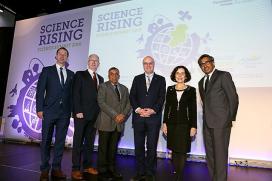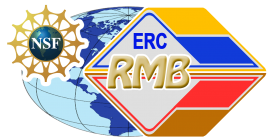U.S.-Ireland Research Collaboration Generates Better Solutions for Bone Fracture
A U.S.-Ireland collaboration is working on a novel magnesium (Mg) based orthopedic implant that can be absorbed into the body once a fractured bone has healed. The research partnership was formed under the National Science Foundation’s (NSF) Center-to-Center (C2C) program by the NSF-funded Engineering Research Center (ERC) for Revolutionizing Metallic Biomaterials (RMB) in the USA, the Science Foundation Ireland (SFI) Centre for Research in Medical Devices (CÚRAM) in the Republic of Ireland, and the Nanotechnology and Integrated Bioengineering Centre (NIBEC) at Ulster University in Northern Ireland. The RMB, which is headquartered at North Carolina A&T State University (NCAT) with partner institutions including the Universities of Pittsburgh (Pitt) and Cincinnati (UC), will lead the development and processing of Mg alloys with input from the two Irish institutions.
A severe bone fracture often requires surgery using metal pins, rods, or plates to ensure it heals in the correct position. These implants are most commonly made from stainless steel or titanium and often need to be removed after a fracture has healed. This research partnership was created to develop next-generation bioresorbable Mg alloy systems for use in orthopedic implant devices to reduce the need for a second surgery for implant removal, improving bone fracture healing while lowering surgical risks to patients and decreasing associated healthcare costs. This device will be especially useful in pediatric patients whose bones are still growing. As a result of efforts to date, a US provisional patent application for the technology has been filed and assigned U.S. Serial No. 62/665,921. While working toward specific technical goals, the collaboration also seeks to foster a culture of innovation in bioengineering research and education, which has already resulted in multiple international keynote presentations about the collaboration and joint scientific papers. RMB’s ERC web seminar series will be leveraged to include this program, and multi-university trans-ERC courses will be extended to include the international partners. The collaboration and its work are expected to draw new enrollments from RMB, CURAM, and NIBEC students across institutional boundaries to promote “outside the box” thinking in the 21st century workforce, and to aid individuals in finding jobs in a wide range of industrial and governmental positions.
Modern industry is global and so should be the training of our current and future researchers. The regulatory landscape, especially for biomedical materials and devices, is highly dependent on intercountry efforts. This tripartite partnership¾which is also supported by U.S. industrial partners OrthoKinetic Technologies LLC, OrthoKinetic Testing Technologies LLC, and Ft. Wayne Metals¾is creating a unique convergence of world-leading expertise. Team members bring unique qualifications to this effort. The US-based ERC-RMB is comprised of NCAT, with its recognized materials research and processing capabilities, Pitt, with expertise in bioengineering, biomaterials and regenerative medicine, and UC, with expertise in smart nanotechnology, engineered systems and test beds. SFI brings an innovative approach to both traditional and new combinational modelling of next generation medical devices from multi-scale design to device manufacturing, and NIBEC brings expertise in medical instrumentation, sensors, diagnostic systems, surface science, and biomaterials coating strategies. As a global team, researchers communicate person-to-person on the different challenges associated with each country’s academic, industrial, and regulatory challenges.



